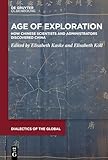Age of Exploration : How Chinese Scientists and Administrators Discovered China / ed. by Elisabeth Kaske, Elisabeth Köll.
Material type: TextSeries: Dialectics of the Global ; 17Publisher: Mnchen ; Wien : De Gruyter Oldenbourg, [2024]Copyright date: 2024Description: 1 online resource (VIII, 292 p.)Content type:
TextSeries: Dialectics of the Global ; 17Publisher: Mnchen ; Wien : De Gruyter Oldenbourg, [2024]Copyright date: 2024Description: 1 online resource (VIII, 292 p.)Content type: - 9783111245171
- 9783111245461
- 9783111245362
- 951
- online - DeGruyter
- Issued also in print.
| Item type | Current library | Call number | URL | Status | Notes | Barcode | |
|---|---|---|---|---|---|---|---|
 eBook
eBook
|
Biblioteca "Angelicum" Pont. Univ. S.Tommaso d'Aquino Nuvola online | online - DeGruyter (Browse shelf(Opens below)) | Online access | Not for loan (Accesso limitato) | Accesso per gli utenti autorizzati / Access for authorized users | (dgr)9783111245362 |
Frontmatter -- On the Series -- Contents -- 1 Introduction -- Part I: Exploration -- 2 Remaking Hinterland Guizhou: Ding Wenjiang’s (1887–1936) Pioneering Geo-surveys in Southwest China -- 3 Meteorological Explorations in Republican China: Observations on Mount Emei and Mount Tai during the International Polar Year 1932/33 -- 4 A Shared Journey for the Chinese Oil Dream: The Yumen Oilfield, Foreign Geologists and the Localization of Chinese Petroleum Geologists -- 5 Infrastructure, Ethnography, and the Integration of Xinjiang: The Northwest Reconstruction Expedition of 1943 -- Part II: Representation -- 6 Re-shaping the Imagined Community: Postal Maps and the Making of National Space for Young China -- 7 The KMT’s Long March: Highways, War, and National Space in China’s Southwest -- Part III: Reclamation -- 8 Planting the Seeds of the Nation: Agricultural Experimental Stations and the Making of the Chinese Geo-Body -- 9 Spatializing the State Through Forest Surveys: Constructing Verticality and Encompassment in the Early Years of the People’s Republic of China -- 10 Experiments with Scale: The People’s Electrification Campaign of 1958–1961 and China’s Pursuit for a New Energy Future -- 11 Conclusion -- List of Contributors -- Index
restricted access online access with authorization star
http://purl.org/coar/access_right/c_16ec
In the early twentieth century, Chinese intellectuals came to realize that Westerners surpassed them not only in knowledge of the world, but also in knowledge of China itself. A rising generation of Chinese scientists, engineers, and administrators was eager to address this state of affairs and began to retrace the footsteps of Western explorers who had crisscrossed China during the preceding century. The nine case studies assembled in this book show how a new cohort of professional Chinese explorers traveled, studied, appropriated, and reshaped national space from the 1920s to the 1950s. In some instances, the explorers drew directly from the fieldwork practices of their Western predecessors. In others, they trained compilers to collect and systematize local knowledge that could be passed up the administrative hierarchy to government and national institutions. Their projects helped to claim natural resources, prepare for infrastructural development, and create new institutionalized knowledge and public engagement with textual representations of China’s geobody. This book elucidates the ways in which knowledge production in early twentieth-century China centered on space and contributed to China’s transformation into a modern nation-state.
Issued also in print.
Mode of access: Internet via World Wide Web.
In English.
Description based on online resource; title from PDF title page (publisher's Web site, viewed 20. Nov 2024)


